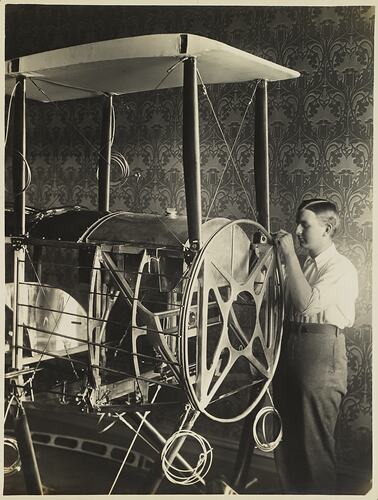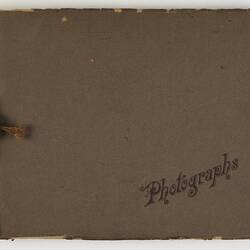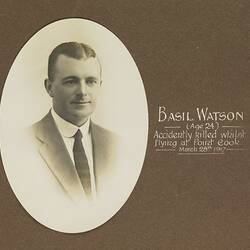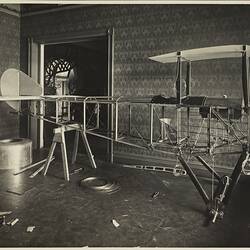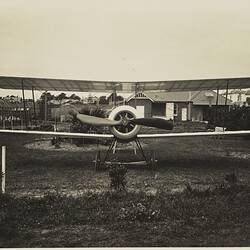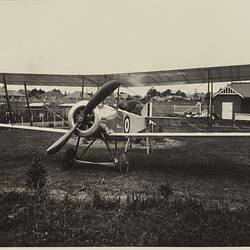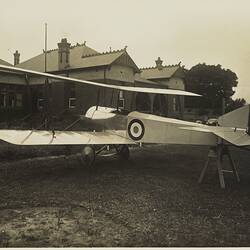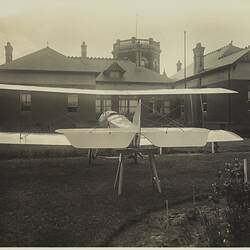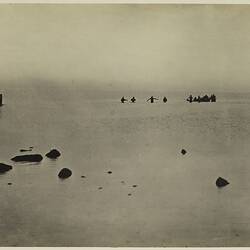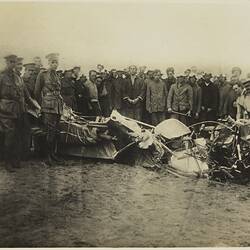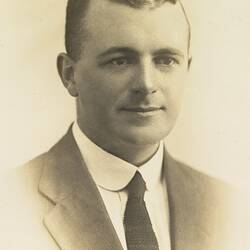Summary
Part of a commemorative photograph album produced by Sears' Studios, Melbourne, documenting the work of Basil Watson in constructing a biplane at his family's home 'Foilacleugh' in Elsternwick, Victoria, during 1916, and the aftermath of his fatal crash off Point Cook on 28th March 1917. The biplane was based on the design of the Sopwith Pup, which Watson was familiar with from his time working as an engineer and test pilot with the Sopwith Aviation Co. and Imperial Army in Britain, during 1914-1916. Watson piloted the plane on pioneering flights to Bendigo and western Victoria. He performed many public acrobatic flying demonstrations and flew the first official airmail between Mt Gambier and Melbourne in February 1917. He was killed when a component of his aircraft failed during an aerobatic demonstration over Point Cook, Victoria, on 28th March 1917, causing the wings to collapse, plunging the aircraft into Port Phillip Bay. His death was the earliest recorded aviation fatality in Australia. His death deeply affected the Watson family, who continued to publish tribute notices in Melbourne's daily newspapers on each anniversary for over a decade.
Description of Content
Portrait of Basil Watson fitting a circular metal engine mounting frame to the front of the partially completed fuselage of his Sopwith-type biplane in the billiard room of the Watson family home 'Foilacleugh' in Elsternwick, Victoria. The fuselage frame is built of timber struts with diagonal bracing wires in each bay, and is yet to be covered with its fabric and metal skin. A series of metal rods provides extra strength to the front end of the fuselage and protection to the cockpit. An arched metal fuel tank is fitted inside the frame above the foreward part of the cockpit. On top of the fuselage are four timber cabane struts and diagonal wire bracing, supporting the central section of the upper wing. Watson's plane was design so that the wings could be removed from the fuselage for ease of transport by road. The background wall is covered in wallpaper with a dark embossed 'fleur de lis' style pattern reflecting the popular architectural and home decorating style of the early 1910s.
Physical Description
Vertical portrait format rectangular gelatin silver emulsion photographic print, glued to a rectangular landscape format brown cardridge paper page, without caption.
More Information
-
Collection Names
-
Collecting Areas
Transport, Home & Community, Images & Image Making, Public Life & Institutions
-
Creator
Sears Studio, Melbourne, Greater Melbourne, Victoria, Australia, 1916
It is not clear whether Sears took all of the original negatives but they appear to have at least printed the photographs in a standard format and mounted them in the commemorative album. -
Person Depicted
Mr Basil G. Watson, Elsternwick, Greater Melbourne, Victoria, Australia, 1916
-
Place & Date Depicted
'Foilacleugh', St Kilda Street, Elsternwick, Greater Melbourne, Victoria, Australia, 1916
-
Format
Photograph, 6" x 8", Black & White
-
Classification
-
Category
-
Discipline
-
Type of item
-
Image Dimensions - Photograph
156 mm (Width), 208 mm (Height)
Vertical portrait format. Dimensions including 3 mm white border.
-
Keywords
Aviation, Aviation Pioneers, Aircraft, Aircraft Manufacture, Biplanes, Fuel Tanks, Fuselages, Homes, House Interiors, Portraits, Wallpaper
